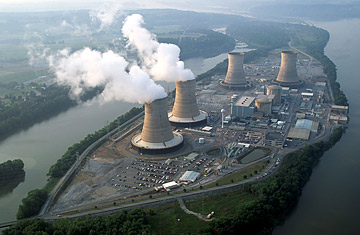
Three Mile Island Nuclear Power Plant
(7 of 11)
Why the possible full-scale flight from the region? The first explanation came from NRC officials. They said the reactor had unexpectedly developed an 880-cu.-ft. gas bubble, which was compressed between the water covering the reactor's core and the top of its steel housing. Acting like a lid on a pressure cooker, the bubble was maintaining high temperatures and pressures. NRC officials warned that there was a very remote but frightening possibility that the bubble would grow big enough to block the flow of water. In that case, the temperature in the core could rise high enough (3,000°) to begin a meltdown, which would require the large-scale evacuation.
The bubble problem had not been anticipated in engineering studies. Said Dudley Thompson, an executive officer of the NRC: "We are in a situation that is not a situation we have ever been in before." As officials studied the complex hazard, they discovered yet another ominous possibility: if the amount of hydrogen in the reactor kept growing, it could reach a level at which only a spark would be needed to set off a hydrogen-gas explosion. If the explosion were powerful enough, the core vessel might rupture and the concrete walls of the container building might break, exposing the surrounding area to the reactor's escaping radioactivity. One NRC official saw this eventuality as in some ways worse than a meltdown. Said he: "With a meltdown you get a warning of four to five hours that it has begun. There's no warning at all of an explosion of hydrogen gas."
Various ways of eliminating the problem were considered by the increasingly anxious engineers. One was to try burning off the hydrogen under controlled circumstances. The second was to gradually raise the pressure inside the reactor to the point that the hydrogen would dissolve in the water at the bottom of the reactor room. The third choice was to lower the water level at the floor of the reactor room and pour fresh water in from the top, thus pushing the bubble toward the bottom and away from the fuel rods. Another possibility was to restart the reactor, generating heat and steam that might break up the bubble. But this option was ruled out because of fears that the control rods might be too bent to be lowered again; if so, the chain reaction could not be controlled.
On Saturday, the engineers began preparing yet another approach to getting rid of the bubble. They continued to vent some of the gas from the containment building in controlled steps. This meant that low-level radiation was still being released from the plant. But it also caused the bubble to shrink slightly. When it became small enough, the engineers hoped that it could be siphoned into a tank in the pump building. Since the gas in the bubble was highly radioactive, a wall of lead bricks had to be built around the tank.
Because preparations would take several days, the engineers said they would not make an attempt to remove the bubble until this week. When they do, said NRC Chairman Joseph M. Hendrie, all people within ten or 20 miles downwind of the plant may be evacuated "if we determine that the process of getting rid of the gas bubble has unsafe elements."
